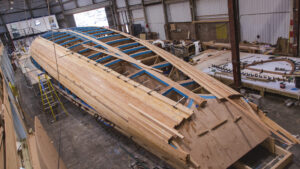One part of the Cleanwreck-Campus is the shipyard. Here we will build exceptionally durable and seaworthy wooden boats and ships for us and all those who want to earn their living in a sustainable and environmentally conscious way with and on the sea and contribute to the protection of the oceans.
Seaworthy, tough workhorses
When considering suitable designs for a series of research boats and ships, the requirements for towing ability, seaworthiness and carrying capacity had to be taken into account in order to fulfill the tasks set. They must also be able to be sailed by smaller crews and offer sufficient space and comfort for guests and crew. Common to all our vessels is our ambition to build highly seaworthy, strong working and research boats and ships from sustainable materials. The wood laminate offers not only an exceptionally good strength-to-weight ratio but also excellent sound and heat insulation and thus a pleasant climate on board. Photovoltaic modules are mounted on the deckhouses, which normally cover the current energy requirements. In addition, the medium and large vessels will be equipped with extremely powerful hydro generators developed by our R&D department, which convert “surplus” wind energy into electrical power.
Workshops, storage rooms, slipway, jetty, mooring

We want to manufacture as much of our boats and ships ourselves as possible. Therefore, the yard will have workshops for woodworking, metalworking, and sailmaking. In addition, there will be a covered slipway (that can even be enclosed with canvas) and storage rooms for wood and other building materials. In the near future there will also be a jetty and, as soon as needed, a buoy field for members and volunteers with own boats. The woodworking workshop is fully equipped with powerful professional machines and tools. The metalworking and sailmaking workshop are still under development.
Building methods and materials

We build predominantly using the strip veneer method and use only hand-picked, winter-cut European timbers such as spruce (Picea abies), larch (Larix decidua) sweet chestnut (Castanea sativa), robinia / black locust (Robinia pseudoacacia L.) and possibly Greenh(e)art (Chlorocardium rodiei – DNV ice skin recommendation) as well as bio-based epoxies with a very high proportion of plant origin. We saw these (no rotary-cut or sliced!) into hand-selected strips and veneers and laminate them skillfully by hand with the resin into the desired shape. This construction method, which is also used, for example, by Spirit Yachts for classic luxury yachts, produces boats and ships of the highest quality and, last but not least, with the greatest possible sustainability due to their very long lifespan. The models, templates, mall frames, etc. on which we laminate the hulls, bulkheads, deck beams, etc., can be reused as often as required, which considerably shortens the construction time in series production. But even with the professional and efficient woodworking machines from our sponsor SCM and the fine tools of many other supporters, this way of building boats and ships is still very demanding in terms of craftsmanship and also very work time intensive and thus only possible with the support of our many volunteers.
More of cold mouldet vessels of other boat and ship builders:
More about cold moulded wood construction:
Range of boats and ships
We will build a wide range of working and research boats and ships. From comparatively small research vessels (SRV) for a crew of three, to large large research vessels (LRV) that can accommodate up to 30 people. The small ones, for example, are excellent for towing a side-scan sonar behind them at 3kn (max. 5kn) even in difficult weather and sea conditions. Due to their hull shape, especially the long keel, they can be easily and comfortably kept on course with windvane steering. With a large number of divers, the huge brigantines can collect remarkable amounts of marine debris and transport it over long distances to the next harbour. Naturally, they need a much larger crew to be able to manoeuvre safely. But this is also one of their most beautiful advantages: here, as in marine conservation in general, everything only works as a team.
[paypal-donation]
